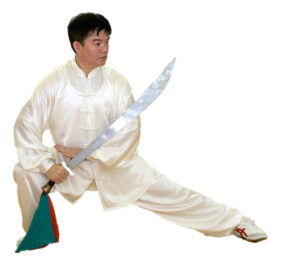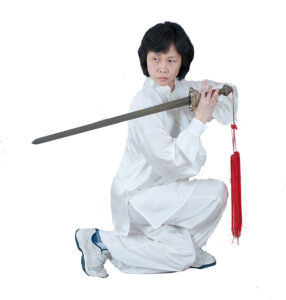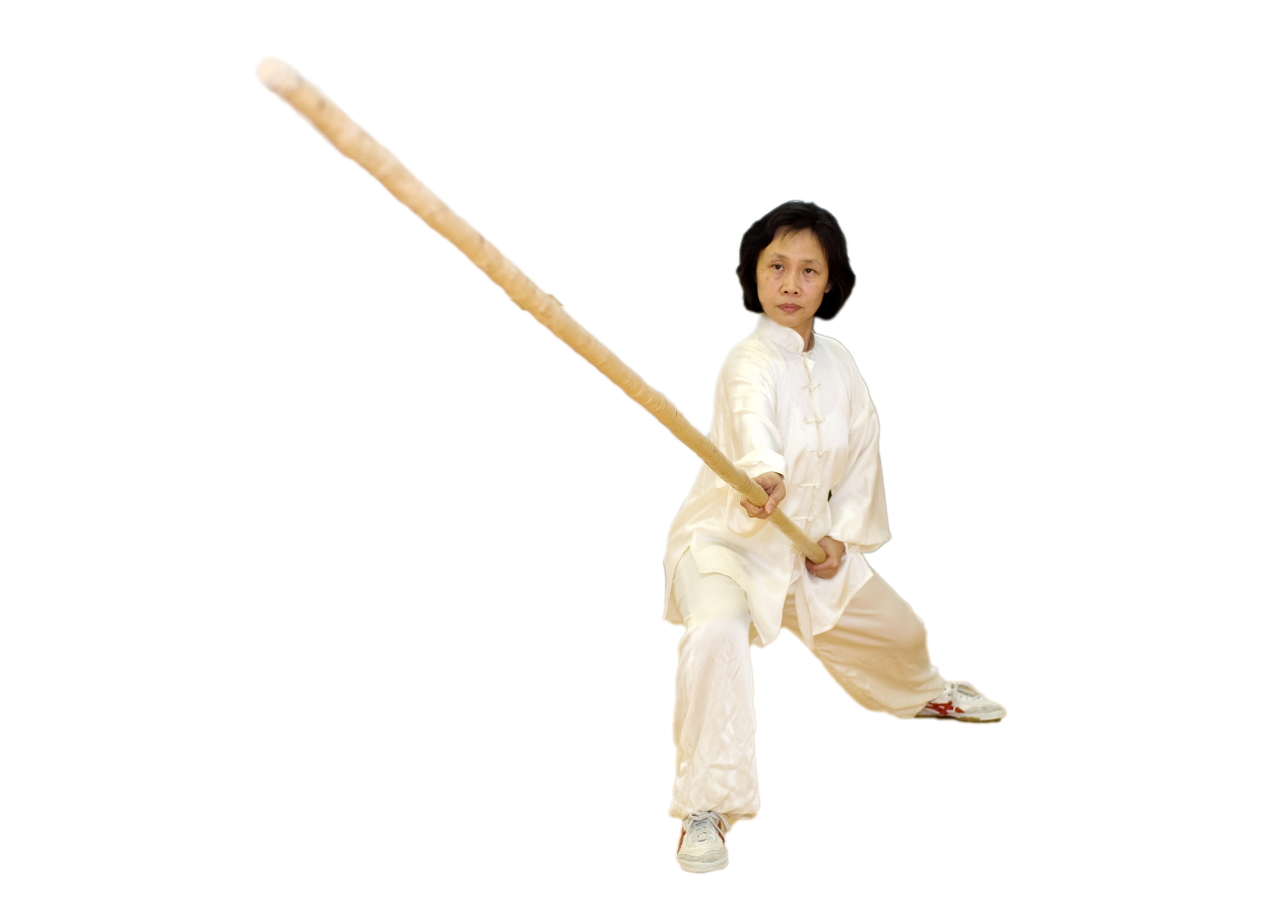If you have heard something about tai chi, you probably think of tai chi as a gentle and slow moving activity with some great health benefits when people practice it daily. Fewer people have an image in their heads of tai chi practitioners as being accomplished martial artists with the deftness and agility to wield weapons such as spears and swords.
Even if we do not see ourselves as a warrior, do not be surprised if you find yourself enjoying a weapons class more than you would care to admit. Surprisingly, what we have found is that more people than we would have ever guessed have found weapons classes to be fun and fulfilling! Regardless of a person’s level of tai chi experience or natural hand-eye coordination, almost all students find weapons classes challenging in new and fanciful ways.
Tai Chi Weapons Training
And, while we talk a lot about tai chi’s health and fitness benefits, people may not always remember or see themselves as practicing a martial art. The reason for slow movements is to improve the quality of training. It provides the deep programming of muscle memory that makes it possible for people to leverage these skills in their day to day lives without much further thought. By moving the body through the entire range one inch at a time, the body becomes aware of how to perform and balance down to the most minute instance of the movement.
When we practice with weapons, it adds an additional dimension to the training of the martial artist’s balance, strength and biomechanics. Besides that, regardless of how gentle and passive a person’s personality, there’s something absolutely exhilarating about being able to wield a weapon successfully and competently. It allows us to feed our inner child who longs to play the capable defender.
Tai chi weapons classes are just plain fun!
How Each Weapon Challenges Our Tai Chi Skills
In history, weapons were used for defence. Today, weapons are training tools to enhance our skills in ways that are not possible with the regular forms. Many of the moves used in the open hand forms are emulated in the weapons forms. The added length and weight of a weapon requires additional strength and improved balance to successfully transition from movement to movement which forces us to become much more sure-footed and balanced.
The four main weapons in tai chi history are the long pole, sabre, spear and sword. However, the long pole is often not considered a weapon but merely a training apparatus.
As the shape and weight of each weapon is different, the training benefits and application of each weapon is equally unique as well. Let`s review how each has been used throughout history both as a weapon and a training tool.
Sabre (刀 – dāo)
 The typical sabre or broadsword is sharp along one edge which starts straight at the hilt and then curves at the tip. On average, the broadsword weighs between 5 and 10 lbs. It is shorter than a straight sword and requires a variety of energetic and quick movements which incorporate many spins. The sabre gets people physically fit, strengthens wrists and improves flexibility of the upper body.
The typical sabre or broadsword is sharp along one edge which starts straight at the hilt and then curves at the tip. On average, the broadsword weighs between 5 and 10 lbs. It is shorter than a straight sword and requires a variety of energetic and quick movements which incorporate many spins. The sabre gets people physically fit, strengthens wrists and improves flexibility of the upper body.
The sabre leverages a lot of physics. To use the tip in a thrust, it requires a recoil and lunge of the body. To use the one sharp edge, a lot of power must be amassed. To do this, using a circular and spin move that leverages centrifugal force is the key to extending the power of our body without prematurely exhausting our muscle power.
The Chinese have a saying that goes: “The Sabre is like a fierce tiger.”
Spear (槍 – qiāng)
The typical spear is made of white wax wood and a spear head trimmed with a red horse hair tassel at the base of the spearhead. The tai chi spear is typically 6 – 7 feet in length. The tai chi spear form incorporates both staff (a.k.a. pole) and spear movements.
The spear requires many small and large sweeping and circular motions. It demands agility as well as strength when wielding the spear. We train to work with the weight and energy of the spear extending beyond the boundaries of our body. We practice a combination of small and large circular motions and thrust motions that require a dexterity and focus to be able to fully extend the arms and spear with steady accuracy.
Overall, wielding a spear requires really good coordination of the hands, eyes, body and feet. Hence it is more difficult to master than the sabre.
Sword (劍 – jiàn)
 The sword is a straight double edged blade which is thicker at the hilt and tapers to a point. A typical sword will weigh 4 – 8 lbs and is wielded with one hand. It is the lightest weapon among the four. The key to a good sword is in the balance of it. A well-balanced sword will feel easy to use even if it is heavier. On the other hand, an unbalanced sword that weighs less will feel heavy and difficult to use.
The sword is a straight double edged blade which is thicker at the hilt and tapers to a point. A typical sword will weigh 4 – 8 lbs and is wielded with one hand. It is the lightest weapon among the four. The key to a good sword is in the balance of it. A well-balanced sword will feel easy to use even if it is heavier. On the other hand, an unbalanced sword that weighs less will feel heavy and difficult to use.
Now, the sword seems easiest to learn due to its light weight. The first time you pick up a sword, it feels seemingly easy to handle. However it becomes clear very quickly how difficult it is to wield the sword in a graceful manner and not appear clumsy. The sword movements test one’s coordination between the sword hand and the rest of the body. It requires flexibility, balance, mental focus and physical fitness of the tai chi practitioner. An expert swords person makes difficult moves appear seemingly easy.
There is a saying in Chinese martial arts: “One hundred days Sabre, One thousand days Spear, and Ten years one Sword.” The sword, while easy to wield and start learning, is by far the most complex and difficult to master.
The sword is the ultimate test of balance with high one legged poses, low stances and coordination of the sword hand with an open chest posture to leverage the opposing movement from the other hand. The use of the sword requires a subtle dexterity to the handling and wielding of power which requires time to master.
A good swordsman does not allow the body to get in the way of the sword. As opposed to looking like a person who has a sword in their hand, onlookers would only notice a sword dancing and flowing gracefully through the air without distraction from an effortless execution of movement by the martial artist.
The Chinese say that: “The sword is like a swimming dragon.”
Long Pole (大桿 – dà gǎn)
The long pole is made of white wax wood as well. However, the poles are a minimum 9 feet to 12 feet long with a 2 – 3 inch diameter at one end of the pole.
The long pole is a training apparatus by virtue of its length and weight. Tai chi training with the long pole involves using the whole body to hold, extend and run circular motions of the pole with steady strength which challenges and develops our core muscles.
Holding a pole in an extended position requires a complete body connection of the arms through the core and to the legs which must be firmly planted to the ground. Pure strength alone won’t be enough for the practitioner to perform the exercises.
The strength of the tai chi stances will be tested and strengthened with regular long pole practice. With improved internal core strength from pole training, when we return to practicing the open hand tai chi forms practice, we find the movements feel more effortless.
Go Beyond with Tai Chi Weapons and Have More Fun!
Learning weapons brings a new level of difficulty to tai chi. It can be challenging and fun at the same time.
Learning how to control a weapon in one’s hand can be an exhilarating experience. Even without achieving mastery of the weapon, you will still be able to enjoy the thrill of practicing tai chi weapons. Keep an eye out for our weapons training sessions, we offer training in different weapons at different times of the year.




I hope that one day I can learn of the ways of being an honorable warrior so that way I can bring honor to my family, but I’m going to need lots of help in finding balance within myself I just don’t know how I will be able to find it without some help, I was hoping maybe someone can help me with my problems and train me.
[…] Chinese spear is one of the four main weapons (spear, sword, saber, and pole) of Tai Chi. A special type of Tai Chi Chinese spear is made of wax […]
[…] lance chinoise en fait partie les quatre armes principales (lance, épée, sabre et perche) du Tai Chi. Un type spécial de lance chinoise de Tai Chi est fait […]